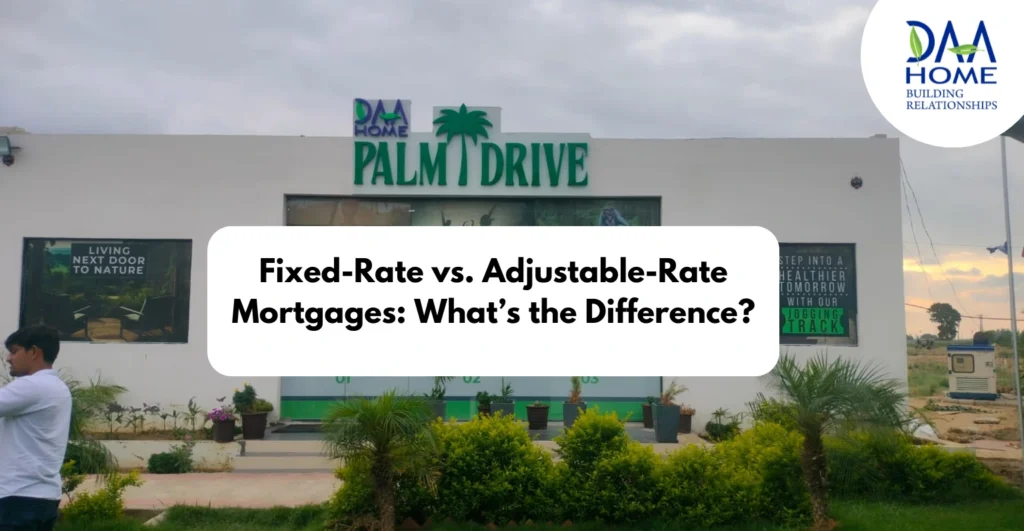When buying a home or a plot, one of the most significant decisions you’ll face is choosing the right type of mortgage. For customers of Daa Homes, a trusted real estate firm in Indri, Karnal, Haryana, which specializes in offering affordable home plots, understanding the difference between fixed-rate and adjustable-rate mortgages (ARMs) is crucial. Both options have pros and cons, and the best choice depends on your financial goals, risk tolerance, and market conditions. Let’s break down the differences to help you make an informed decision.
Understanding Fixed-Rate Mortgages
A fixed-rate mortgage is a home loan with an interest rate that remains constant throughout the loan’s term. This means your monthly payments for principal and interest will stay the same, providing predictability and stability.
Key Features of Fixed-Rate Mortgages
- Stable Monthly Payments: Fixed-rate mortgages offer consistent payments, making it easier to budget over the long term. This is especially helpful for families who value financial stability.
- Long-Term Security: Regardless of changes in market interest rates, your loan’s interest rate remains locked. This protects you from potential rate increases in the future.
- Various Loan Terms: Fixed-rate mortgages often come in terms of 10, 15, 20, or 30 years, allowing borrowers to choose the repayment period that best suits their financial situation.
Pros of Fixed-Rate Mortgages
- Predictable payments make budgeting easier.
- Protection against rising interest rates.
- Ideal for long-term homeowners who plan to stay in one property for many years.
Cons of Fixed-Rate Mortgages
- Higher initial interest rates compared to ARMs.
- If market rates drop, you won’t benefit unless you refinance.
Understanding Adjustable-Rate Mortgages (ARMs)
An adjustable-rate mortgage has an interest rate that changes periodically, typically in relation to a benchmark index. ARMs usually start with a lower initial rate than fixed-rate mortgages, making them appealing for short-term homeowners or those expecting income growth.
Key Features of Adjustable-Rate Mortgages
- Lower Initial Rates: ARMs often have a lower starting interest rate, making monthly payments more affordable during the initial fixed period (e.g., 5, 7, or 10 years).
- Periodic Adjustments: After the initial period, the rate adjusts periodically based on the market index plus a margin set by the lender.
- Rate Caps: Most ARMs include caps that limit how much the rate can increase per adjustment period and over the loan’s lifetime.
Pros of Adjustable-Rate Mortgages
- Lower initial rates can save money in the short term.
- Potential to benefit from falling interest rates without refinancing.
- Ideal for those planning to sell or refinance before the rate adjusts.
Cons of Adjustable-Rate Mortgages
- Payments can increase significantly if rates rise.
- Harder to budget due to unpredictability after the initial fixed period.
- Riskier for long-term homeowners.
| Key Differences Between Fixed-Rate and Adjustable-Rate Mortgages | ||
| Aspect | Fixed-Rate Mortgages | Adjustable-Rate Mortgages |
| Interest Rate | Remains the same for the loan’s term | Changes after the initial period |
| Monthly Payments | Stable and predictable | May increase or decrease |
| Initial Costs | Higher initial rate | Lower initial rate |
| Suitability | Long-term stability | Short-term affordability |
Choosing the Right Mortgage for Your Needs
The choice between a fixed-rate and an adjustable-rate mortgage depends on several factors, including:
1. Your Financial Goals:
- If you value stability and plan to stay in your home for a long time, a fixed-rate mortgage is ideal.
- If you anticipate selling the property or refinancing within a few years, an ARM might be a better option.
2. Market Conditions:
- In a low-interest-rate environment, locking in a fixed rate can be advantageous.
- If rates are high, starting with a lower ARM rate may save you money initially.
3. Risk Tolerance:
- Fixed-rate mortgages are better for those who prefer predictability.
- ARMs suit borrowers willing to take on some risk for potential savings.
4. Future Plans:
- For short-term homeowners, the lower rates of an ARM can be cost-effective.
- For those planning to stay put, a fixed-rate mortgage provides long-term security.
Real-Life Example: Fixed-Rate vs. ARM for Daa Homes Customers
Imagine a family buying an affordable plot from Daa Homes to build their dream home. If they plan to live there long-term, they might opt for a 20- or 30-year fixed-rate mortgage to ensure predictable payments. However, if they’re investing in the plot for resale or plan to relocate within a few years, an ARM with a 5-year fixed period could offer significant savings upfront.
The Role of Professional Guidance
Navigating the complexities of mortgage options can be daunting. That’s why partnering with a reliable real estate firm like Daa Homes is essential. With expertise in the local market and a commitment to helping customers make informed decisions, Daa Homes can guide you through the process of selecting the best financing option for your needs.
Conclusion
Both fixed-rate and adjustable-rate mortgages have their merits and drawbacks, and the right choice depends on your unique circumstances. At Daa Homes, we’re here to help you navigate these decisions, ensuring you find an affordable home plot that meets your goals while securing the right mortgage to finance it.
Whether you prioritize stability or flexibility, understanding these mortgage types will empower you to make confident choices. Reach out to Daa Homes today to explore your options and take the first step toward owning your dream property in Indri, Karnal, Haryana.
